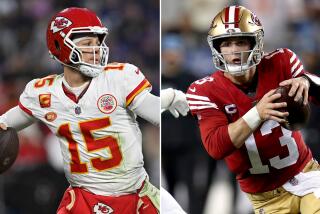SUPER BOWL REPORT
- Share via
When Charlton Heston starred in this sadly underappreciated 1969 flick, America was enduring a painful reassessment of its good-guy image. In previous years we’d witnessed street rioting from Newark to Watts and the assassinations of Martin Luther King Jr. and Bobby Kennedy and public opinion had turned against America’s involvement in the Vietnam conflict.
The National Football League also was searching its soul, after the rival American Football League’s New York Jets shocked the NFL champion Baltimore Colts in Super Bowl III. Jets star quarterback Joe Namath, a hirsute, playboy bachelor, was the anti-establishment antithesis of the clean-cut Bart Starr-type signal callers of yore.
Heston captured the shaky tenor of the times, both on and off the gridiron, with his brilliant turn as Ron “Cat” Catlan, an aging New Orleans Saints QB who doesn’t know when to hang up his shoulder pads. The character is believed to have been partly inspired by Y.A. Tittle’s final, bloodied campaign with the New York Giants.
Heston’s wary eyes and slow-burning manner perfectly convey the Cat’s resentment at being shoved aside like a redundant factory worker. Neither the steadfast support of his wife (Jessica Walter) or the groupie-like devotions of his mistress (Diana Muldaur) can keep the Cat’s ego, as well as his 40-year-old body, from eventually imploding.
New York Times film reviewer Howard Thompson wrote that Heston “tackled a starkly unadorned role in one of the most interesting and admirable performances of his career” and called the film a “brooding, scorching and beautifully disciplined tour de force for the actor.”
The ironically titled “Number One” prefigured a string of “revisionist” books and movies of the 1960s and ‘70s that set out to “expose” what was deemed to be the brutal, authoritarian and juvenile culture of pro sports. “Number One,” written by David Moessinger and directed by Tom Gries, also was notable for the crunching credibility of its action sequences. (Heston received passing tips from Saints playcaller Billy Kilmer.)
Alas, the movie loses points for verisimilitude in its very last scene when (if my memory serves) we hear the PA announcer’s voice naming “Niland” as one of the Cowboys involved in the possibly lethal gang tackle of the Cat. In real life, John Niland was a Cowboys All-Pro offensive guard, not a defender.
Incidentally, good luck trying to find a copy of this gem. It’s rarer than a mint-condition Johnny Unitas rookie-season trading card.
-- Reed Johnson
More to Read
Go beyond the scoreboard
Get the latest on L.A.'s teams in the daily Sports Report newsletter.
You may occasionally receive promotional content from the Los Angeles Times.











